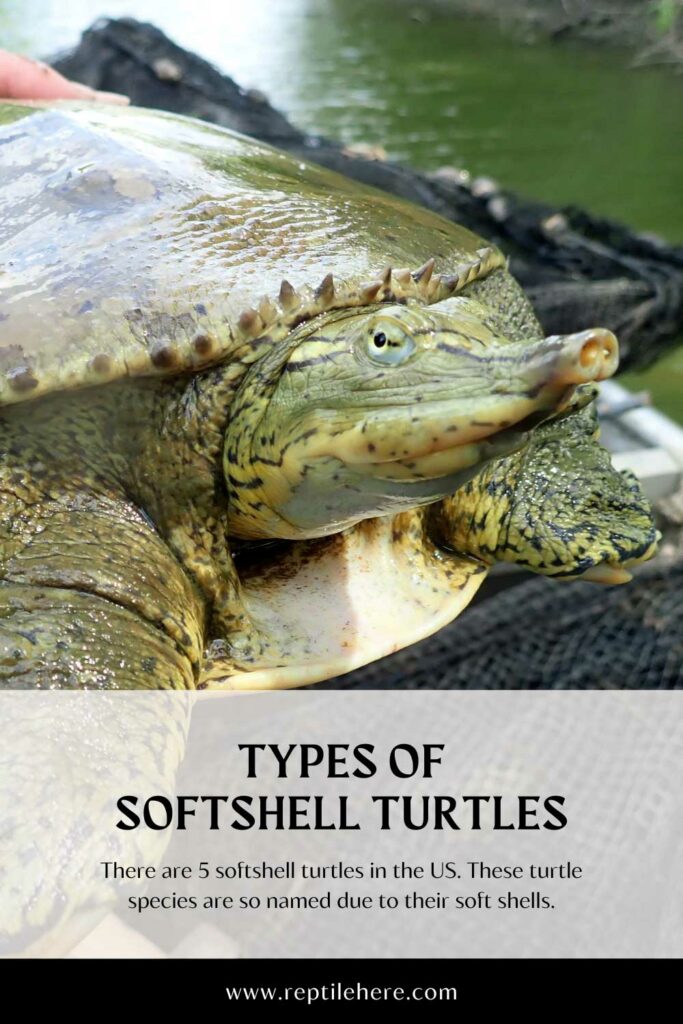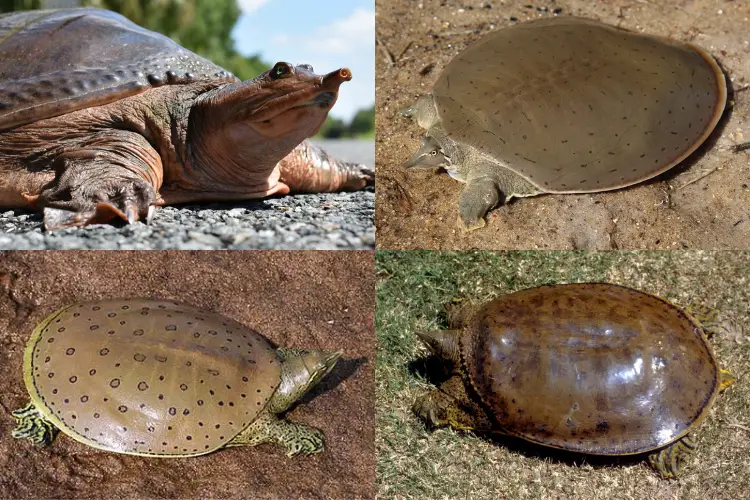Types of Softshell Turtles
There are 5 softshell turtles in the US. These turtle species are so named due to their soft shells. They lack hard shells, with bony plating and scutes found in other turtles.
Though they may differ in physical appearance, these softshells share many characteristics and be various.
Most of them are found in freshwater bodies such as slow-moving rivers, and lakes. Some can also survive in brackish waters.
Below, we have listed the 4 types of softshell turtles found in the US and the basics you need to know about each of them.
For each turtle, you’ll learn the basics such as physical appearance, average adult size, habitat, diet, conservation status, and more.
1. Florida Softshell Turtle
Contents
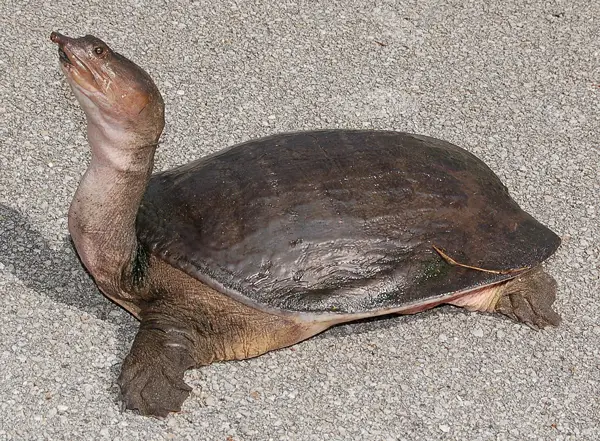
- Scientific name: Apalone ferox
- Common name: Florida Softshell Turtle, Softshell Turtle
- Family: Trionychidae
- Size: 11 to 24 inches (females), 6 to 12 inches (males)
- Lifespan: 50+ years
- Conservation status: Least Concern
Florida softshell turtle is the largest softshell species native to the regions of Alabama Georgia, South Carolina, and Florida!
This softshell species is marked by a dark brown to olive green upper shell with a leathery texture and pancake appearance. The plastron is usually white or gray.
Florida softshell turtles are mainly carnivorous and will feed on insects, worms, mollusks, and fish strips.
The turtle is almost fully aquatic and prefers residing in shallow and muddy water bodies like slow-moving streams and ponds. Its thin snout enables it to breathe while still being submerged in the water as it hides from predators or hunts for food.
Note that this Florida softshell turtle is fast both on land and in the waters!
They don’t like being handled and will often try resisting by biting or scratching with their teeth or sharp claws. They can also be kept as pet turtles, and are ideal for more advanced pet owners.
2. Eastern Spiny Softshell
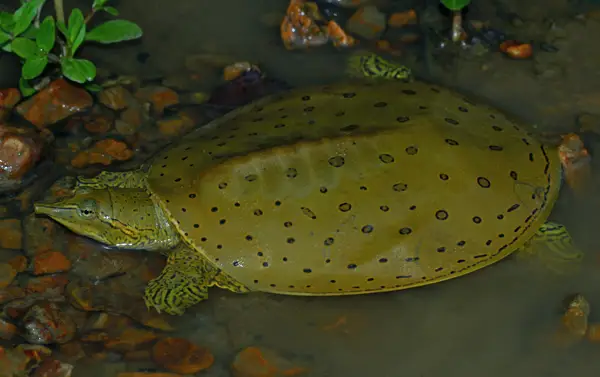
- Scientific name: Apalone spinifera
- Common name: Spiny Softshell Turtle
- Family: Trionychidae
- Size: 5 to 9 inches (males), 12 to 20 inches (females)
- Lifespan: 30 to 70 years
- Conservation status: Least Concern
The Eastern Spiny softshell turtle is a medium-to-large freshwater species that prefer lakes, streams, and rivers with muddy or sandy bottoms and little or no vegetation.
Spiny softshells generally have leathery, pancake-like shells. Both turtle subspecies have shell colors ranging from tan to brown.
The gulf coast has a series of black bars that run around the rim of its shell and ring markings on upper shell. And this distinguishes it from the eastern spiny shell.
Eastern Spiny softshell turtles are mainly carnivorous and like eating anything they find in the waters including crayfish, insects, small fish, and so on.
They hunt by burying themselves in the mud or sand while keeping their head uncovered to grab food as it swims by.
3. Western Spiny Softshell
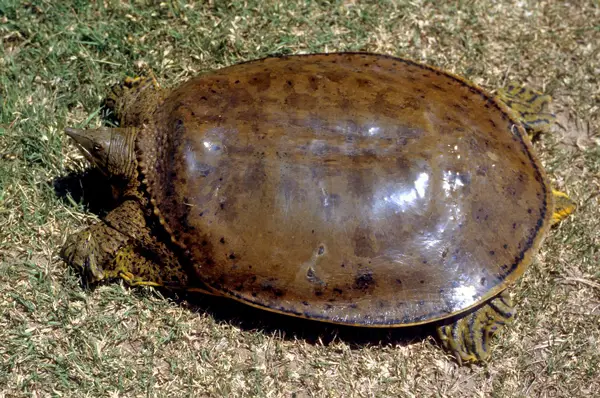
- Scientific name: Alpalone spinifera hartwegi
- Common name: Spiny Softshell Turtle
- Family: Trionychidae
- Size: 5 to 9 inches (males), 12 to 20 inches (females)
- Lifespan: 30 to 70 years
- Conservation status: Least Concern
The Western Spiny softshell turtle is a medium-to-large freshwater species and lives in lakes, streams, and rivers with muddy or sandy bottoms and little or no vegetation.
Female spiny softshell turtles are usually larger than males. And unlike other turtles, this species has a flexible, leather-like carapace that’s extremely rounded and flattened.
The shell color can be olive-grey or yellow-brown. Just like other softshell turtles, this species also has a snorkel-like snout.
The young ones feature well-defined round spots that are easily visible on the shell (though these spots become invisible as they transition to adulthood).
Spiny softshell turtles tend to eat anything they find in the waters including crayfish, insects, small fish, and so on. They hunt by burying themselves in the mud or sand while keeping their head uncovered to grab food as it swims by.
These turtles are also able to breathe underwater by taking in oxygen through their throat skin. This is a useful adaptation given that they don’t spend a lot of time out of water.
4. Smooth Softshell Turtle
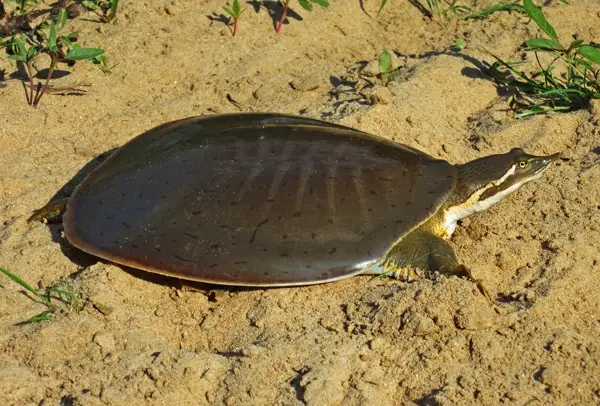
- Scientific name: Apalone mutica
- Common name: Smooth Softshell
- Family: Trionychidae
- Size: 6 to 13 inches
- Lifespan: 40 to 60 years
- Conservation status: Least Concern
There are two species of smooth softshell turtles—the gulf coast smooth softshell and midland smooth softshell turtle.
The turtles are fast, which enables them to outrun their predators given that their soft shells don’t offer much protection.
Shell color of a smooth softshell turtle species ranges from olive to dark brown. The upper part of its shell features dark markings (with female markings appearing in a blotchier pattern than the males’)
The shell of these turtles also appears rounder and flatter, just like other softshell species.
The main difference existing between the two subspecies is size, with the Gulf coast turtle being the bigger guy (it reaches a maximum of 12 inches long). Also, the Gulf coast species has no lines on its face while the midland smooth softshell turtle does.
These turtles like inhabiting waterbodies like rivers and streams that provide an abundance of mud or sand at the bottom. They can also be found in stagnant waterbodies.
Smooth softshells are omnivorous and their diet revolves around aquatic vegetation and insects. However, they have been observed to like meat more than plant matter and will mainly eat snails, insects, and fish.
5. Chinese Softshell Turtle
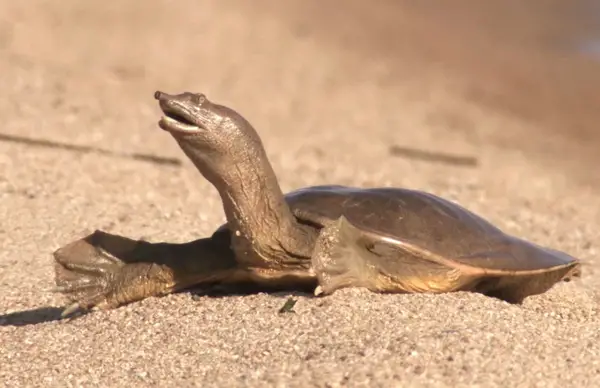
- Scientific name: Pelodiscus sinensis
- Common name: Chinese Softshell Turtle, Asiatic softshell turtle, dwarf softshell turtle
- Family: Trionychidae
- Size: 11 to 13 inches
- Lifespan: up to 25 years
- Conservation status: Vulnerable
As you can easily tell from its name, this turtle species is native to Asia. It found itself in the Hawaii islands as a result of Asian immigrants who used to hunt them for food between the period of 1800s and WWII.
A species of softshell turtle, this species has a leathery and flexible carapace, especially at the sides. The carapace usually has olive color and may feature dark blotches. And the lower side of the shell is orange-red and may feature dark blotches.
In terms of diet, this turtle is predominantly carnivorous and feeds on fish, mollusks, insects, and crustaceans. However, it will occasionally feed on aquatic vegetation.
This Chinese softshell turtle is highly aquatic compared to similar types of turtles. It is fond of swimming (it does this a lot!) and will only occasionally be seen venturing into the dry land.
It is mainly found in fresh as well as brackish water. In Hawaii, it resides in drainage ditches and marshes. Oahu is one particular Hawaiian island where these turtles are common.
Unfortunately, the population of this turtle species keeps declaiming and it has been labeled as vulnerable species by the IUCN. Countless specimens of this turtle are being bred for food, which further contributes to its population decline.
Conclusion
The 4 softshell turtles you’ll find in the US include the Florida softshell, eastern softshell, western softshell, smooth softshell turtles, and the Chinese softshell turtle.
As you can see from the above list, all the softshells share many characteristics and behaviors despite the slight differences in physical appearance.
Most of these turtles prefer living in freshwater bodies like slow-moving rivers and streams, and lakes. Their diet is omnivorous and will feed on both aquatic vegetation and insects.
It is also worth noting that softshell turtles are generally not endangered species, hence they all fall under the IUCN conservation status of “Least Concern.”
